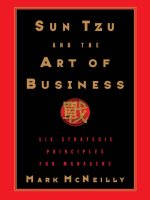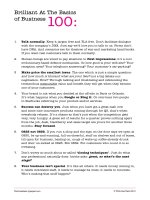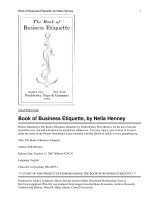The basics of business management – vol i
Bạn đang xem bản rút gọn của tài liệu. Xem và tải ngay bản đầy đủ của tài liệu tại đây (4.46 MB, 284 trang )
ELLY R. TWINEYO KAMUGISHA
THE BASICS
OF BUSINESS
MANAGEMENT – VOL I
LEADERSHIP, FINANCIAL
MANAGEMENT AND
ECONOMICS
Download free eBooks at bookboon.com
2
The Basics of Business Management – Vol I: Leadership, Financial Management and Economics
1st edition
© 2017 Elly R. Twineyo Kamugisha & bookboon.com
ISBN 978-87-403-1594-3
Peer review by Timothy Esemu (PhD)
Download free eBooks at bookboon.com
3
THE BASICS OF BUSINESS
MANAGEMENT – VOL I
CONTENTS
CONTENTS
The Basics of Business Management – Vol. I: Leadership, Financial
Management and Economics
1
Part I: Leaders And Managers
7
Introduction to management and leadership
8
Part II: Financial Management
29
2
Management of Cash
30
3
Credit Management
36
4
Management of Working Capital
37
5
Financial ratios and investment analysis
49
www.sylvania.com
We do not reinvent
the wheel we reinvent
light.
Fascinating lighting offers an ininite spectrum of
possibilities: Innovative technologies and new
markets provide both opportunities and challenges.
An environment in which your expertise is in high
demand. Enjoy the supportive working atmosphere
within our global group and beneit from international
career paths. Implement sustainable ideas in close
cooperation with other specialists and contribute to
inluencing our future. Come and join us in reinventing
light every day.
Light is OSRAM
Download free eBooks at bookboon.com
4
Click on the ad to read more
THE BASICS OF BUSINESS
MANAGEMENT – VOL I
CONTENTS
Part III: Microeconomics
103
Introduction
104
6
Supply and Demand
110
7
Theory of Production
134
8
Market Structures and Competition
156
Part IV: Macroeconomics
169
Introduction
170
9
Economic Growth and Economic Development
171
10
Population, Unemployment and the Labour Market
191
11
International Trade
196
12
National and International Competitiveness
209
13
Consumption, Saving and Investment
224
14
Money, Banking and the Financial System
231
15
Public Finance and Fiscal Policy
251
16
Foreign Aid
262
Endnotes
268
The Basics of Business Management – Vol II: Marketing, Logistics,
Procurement and Law
Part I: Marketing and International Business
Vol. II
1
The Marketing Environment
Vol. II
2
The Marketing Mix
Vol. II
3
Consumer Behaviour
Vol. II
4
Market Segmentation
Vol. II
5
Branding
Vol. II
6
Services Management
Vol. II
Download free eBooks at bookboon.com
5
THE BASICS OF BUSINESS
MANAGEMENT – VOL I
CONTENTS
7
Relationship Marketing
Vol. II
8
Industrial Marketing
Vol. II
9
International Marketing
Vol. II
Part II: Logistics Management
Vol. II
10
Logistics Management
Vol. II
11
Reverse Logistics
Vol. II
12
International Logistics
Vol. II
Part III: Procurement
Vol. II
13
Procurement and Disposal Management
Vol. II
14
Outsourcing
Vol. II
15
e-Procurement
Vol. II
16
Project Procurement
Vol. II
Part IV: Legal Issues in Business Management
Vol. II
17
Law of Contract
Vol. II
18
Sale of Goods Act and Supply of Goods and Services Act
Vol. II
19
Agency and Bailment
Vol. II
20
Intellectual Property Rights
Vol. II
21
Insurance
Vol. II
Endnotes
Vol. II
Download free eBooks at bookboon.com
6
PART I: LEADERS AND MANAGERS
Download free eBooks at bookboon.com
7
THE BASICS OF BUSINESS
MANAGEMENT – VOL I
1
INTRODUCTION TO MANAGEMENT AND LEADERSHIP
INTRODUCTION TO
MANAGEMENT AND LEADERSHIP
In this introductory part, we will begin by understanding the basic deinitions of the concepts.
What is an organisation?
We can simply refer to an organisation as a collection of people working together to achieve
a common goal. hese people are working together to achieve a common purpose, which is
usually the organisation’s set objectives. Working together, people are able to accomplish tasks
that one individual would not have been able to do. Organisations are supposed to have a
vision, mission, goals and objectives. hey undertake various activities which emanate from
those goals. Some scholars have asserted that organisations are systems of inter-dependent
human beings1. Organisations are supposed to do what an individual human being would
not do or achieve alone.
What is management?
Several deinitions of management have been given. According to Peter Drucker (1955)2, a
management guru, management is concerned with a systematic organisation of economic
resources to make these resources productive. Other deinitions look at what management
does. Such deinitions refer to management as the process of planning, organising, leading
and controlling the eforts of organisation members and using all other organisational
resources to achieve stated organisational goals3;.
Organisational behaviour: To understand organisations and management, we need to irst
understand organisational behaviour. his is a multi-disciplinary ield which studies the
individual, group and organisational processes in order to know the behaviour of people in
an organisational setting. here are various deinitions of the concept. Pheysey et al. (1971)4
referred to organisational behaviour as “the study of structure, functioning and performance
of organisations and the behaviour of groups and individuals within them”.5
Leadership: his is a common term. But what does it mean? If you asked a group of top
executives in any part of the globe why organisations succeed, you will most likely hear them
all say “executive leadership.” Indeed, leadership is the way to success for all organisations –
business, politics, sports and the family. In fact Aristotle, the philosopher, advised that if
you cannot lead and manage your family, you should not aspire to enter politics. Indeed, he
viewed the ancient Greek polis (ancient Greek city state) as starting from family to forming
villages and inally the city state (e.g. ancient city state of Athens).
Download free eBooks at bookboon.com
8
THE BASICS OF BUSINESS
MANAGEMENT – VOL I
INTRODUCTION TO MANAGEMENT AND LEADERSHIP
We can deine leadership as the process of directing and inluencing others to achieve group
goals. hese groups are usually in organisations. Leaders are usually people who have a lot
of inluence over others. Regarding leadership, we could note the following:
i. A leader inluences other people who may be followers or subordinates;
ii. here is unequal distribution of power between the leader and those that are led
(the group mates); and
iii. Leadership involves using diferent types of power to inluence the subordinates’
behaviour.
Qualities of leadership: here are various studies that have suggested qualities that people
often associate with leadership. We shall look at the following (Fiedler 19676):
• Has vision and is committed to the purpose or goals of the organisation;
• Guiding others through providing a role model and through willingness to serve
others irst;
• Optimism – Very few pessimists become leaders;
• Dedication of one’s life to serve a cause;
• A clear sense of purpose;
• Self-knowledge; and
• Ability to encourage and nurture those that report to them.
Leadership styles: Tannenbaum and Schmidt (1973)7 developed a leadership style continuum
grouping leaders into three categories. Based on the use of authority, leaders can be referred
to as the following:
i. Autocratic – A leader who commands and expects compliance without question.
Such a leader is dogmatic and is willing and able to give or withhold rewards or
administrative punishments;
ii. Participative (or democratic) – A leader who consults with subordinates on the proposed
decisions and actions and encourages participation from those subordinates; and
iii. Free Rein (laissez-faire) – Leaders who use very little if at all of their power but
instead give their subordinates a high level of independence in their work.
Download free eBooks at bookboon.com
9
THE BASICS OF BUSINESS
MANAGEMENT – VOL I
Leadership style
INTRODUCTION TO MANAGEMENT AND LEADERSHIP
Behaviours demonstrating leadership style
Autocratic
• Leader take decisions without reference to anyone else
• There is a high degree of dependency on the leader because
staff are not encouraged to make suggestions on the running
of the organisation
• This style can demotivate staff and result in a high staff turnover
Democratic
• Leaders encourage discussion and debate throughout the group
before inal decisions are actually – and implemented.
• Leaders consult and also persuade the team before implementing
a decision
• This approach motivates staff as they feel involved in the process
of decision-making
• This can improve development and sharing of ideas and
experiences within the organisation
Laissez-faire
• Leaders exhibit ‘let it be’ as it is – leadership responsibilities
are shared by all – and the leader leaves it to the group
• This approach is useful in entities where creative ideas are
important
• Can be highly motivational as people have control over their
own working life, without unnecessary restrictions from authority
• This approach relies on good team and on good interpersonal
relations between the group
Table 1: Leadership styles
McGregor’s heory X and theory Y
Douglas McGregor (1960)8, in his book – he Human Side of Enterprise – broadly set out
two approaches to human nature which he termed heory X and heory Y. McGregor
believed that the way people were managed afected their work behaviour and attitudes. He
proposed a consultative approach to management as a way to encourage heory Y behaviour
among staf. According to him, heory X places exclusive reliance upon external control of
human behaviour, while heory Y relies more on self-control and self-direction.
Download free eBooks at bookboon.com
10
THE BASICS OF BUSINESS
MANAGEMENT – VOL I
INTRODUCTION TO MANAGEMENT AND LEADERSHIP
Theory Y9
Theory X
• People are passive – even resistant
to organisational needs. They must
be persuaded, rewarded, punished,
controlled – their activities must be directed.
• The average man is by nature indolent –
they work as little as possible
• People lack ambition, dislike responsibility
and prefer to be led.
• They are inherently self-centred and
indifferent to organisational needs
• They are by nature resistant to change
• People are not by nature passive or
resistant to organisational needs
• People will exercise self-control and
self-direction towards achieving the
organisational objectives
• People are motivated and ready to
work and achieve organisational goals
• The essential task of management is
to arrange organisational conditions
and methods of operations so that
people can achieve their goals.
Table 2: Theory X and Theory Y Source: Adapted from McGregor, D., 1960. The Human Side of Enterprise
(McGraw-Hill)9
Management Process: Henri Fayol (1903)10 was one of those management theorists who
undertook a systematic approach to analysing and deining the job of managers. He gave
managers ive functions:
1. Planning: setting organisational objectives and the methods of achieving them.
2. Organising: establishing the structure of tasks to be performed to realise the set
goals and objectives.
3. Commanding: giving instructions to the subordinates to undertake tasks.
4. Coordinating: harmonising the activities of individuals and groups within the
organisation in order to help an organisation to perfect and achieve its objectives.
5. Controlling: monitoring which is continuous during implementation and evaluation
(which is an audit) of the activities in order to correct activities and ensure that
work is done according to plans.
An efective manager must:
1.
2.
3.
4.
5.
6.
Identify symptoms causing problems within an organisation;
Analyse or diagnose the causes of the situation;
Propose how it might be solved;
Suggest treatment and monitor progress;
Develop strategies to prevent further problems; and
Control and evaluate performance of his/her staf.
Download free eBooks at bookboon.com
11
THE BASICS OF BUSINESS
MANAGEMENT – VOL I
INTRODUCTION TO MANAGEMENT AND LEADERSHIP
Some brainstorming sessions may produce a list of characteristics that efective managers
have. hese include the following:
Leadership
Visionary
Self-starter
Good communicator
Analytical
Decisive
Trusted
Knowledgeable
Alert
Persuasive
Diferentiating Leaders and Managers
he McKinsey 7-S framework
In 1982, Peters and Waterman11 developed a model that may help us to distinguish between
managers and leaders – the 7-S framework which shows the link between ’hard’ and ‘soft’
skills. Hard technical skills – structure, strategy and systems – were proposed as distinctive
competences of managers while the soft, people-oriented skills – skills, style and staf –
were proposed as more distinctive in leaders. Both the managers and leaders were linked
together by the shared values.
We should emphasize that modern approaches to business management recognise the need
for a leader to be a good manager too.
Leadership
Senior management 20:80
Middle management 50:50
Management
First line management 80:20
Figure 1: Balance between leadership and management
Download free eBooks at bookboon.com
12
THE BASICS OF BUSINESS
MANAGEMENT – VOL I
INTRODUCTION TO MANAGEMENT AND LEADERSHIP
Behavioural traits of successful leaders
he behavioural theories have focused on what leaders actually do – the leadership styles.
•
•
•
•
•
•
•
•
•
•
•
Physique
Technical knowledge
Intelligence
Perception and caring
Courage and risk-taking
Persistence
Innovation and creativity
Position in the organisation
Subjective assessment by subordinates
Peer assessment
Length in an organisation
Table 3: Behavioural traits of successful leaders
Authority, Delegation, Responsibility and Accountability
Delegation of authority: Delegation refers to the process of assigning work from the top to the
lower level of an organisation (from superior to the subordinate). he person who has been
delegated has authority to accomplish the assigned task. he process of delegation involves:
•
•
•
•
Allocation of duties
Delegation of authority
Assignment of responsibility
Creation of accountability
Authority: his is the right to take a inal decision. It moves in a downward direction, from
a supervisor to a junior.
Responsibility: his is the obligation to perform the duty. Responsibility cannot be delegated.
Accountability: he person that has been delegated (the subordinate) must be held answerable
to the duties that they have carried out.
Download free eBooks at bookboon.com
13
THE BASICS OF BUSINESS
MANAGEMENT – VOL I
INTRODUCTION TO MANAGEMENT AND LEADERSHIP
Stakeholder mapping and stakeholders inluence
Stakeholders: he stakeholders of an organisation are all those individuals or organisations
that have an interest in an organisation. hey include the following:
•
•
•
•
•
Shareholders
Employees
Consumers
Suppliers
Competitors
•
•
•
•
•
Financial institutions
Government
Local community
Non-Governmental Orgainsations
The media
Figure 2: Organisation’s stakeholders
Stakeholder mapping: Every organisation needs to know their stakeholders well. he power
(or inluence) and level of interest that each key stakeholder has needs to be understood in
order to manage the organisation’s relations with each of them.
Inluence: Stannack (2003) deines inluence as the apparent ability to use power12. Inluence
is importance because it helps leaders and managers to obtain compliance, obedience,
conformity and commitment from their people13.
360°
thinking
.
Discover the truth at www.deloitte.ca/careers
Download free eBooks at bookboon.com
14
© Deloitte & Touche LLP and affiliated entities.
Click on the ad to read more
THE BASICS OF BUSINESS
MANAGEMENT – VOL I
INTRODUCTION TO MANAGEMENT AND LEADERSHIP
Sources of power of stakeholders: Johnson and Scholes (1999)14 explain stakeholders’ sources
of power in two ways.
• Internal stakeholders (within the organisation): he chain of command – hierarchy
which is formal with power control of strategic resources, possession of knowledge
and skills.
• External stakeholders: hey have control of strategic resources of key raw materials
or money (like a bank) or possession of knowledge and skills.
Managing stakeholders
To be able to manage diferent stakeholders, the organisation needs to understand their level
of inluence (power) and their level of interest. he power or inluence can either be high
or low. It is the same for interest. hose who have both high inluence and high interested
should always be involved in the key activities or programmes of the organisation. Such
stakeholders include shareholders, managers and, in some cases, the government.
Power and Authority
Power can be referred to as the ability for a leader or manager to take action. Authority
will then be referred to as the right to take action. In management, the person supposed
to take action should have the power to do so.
here are seven diferent sources of power, ive of them originally proposed by French and
Raven (1959)15:
1. Legitimate power (position power) – his is power which comes with the position that
one holds within a group or organisation. he subordinates will accept instructions
or even orders from their managers. his is often referred to as position power.
Managers have authority because of their position within the formal structure of
the organisation. Every organisation has an organogram showing reporting and
responsibilities of diferent levels of management and oicers.
2. Reward power – his refers to the extent to which the manager uses the intrinsic
and extrinsic rewards to control other people in the organisation. It is about having
the authority to use an entity’s resources for rewards or recognition as perceived
by the follower. For example, the manager who has the power to reward can ofer
the supervisee more pay, perks, promotion or more responsibility.
Download free eBooks at bookboon.com
15
THE BASICS OF BUSINESS
MANAGEMENT – VOL I
INTRODUCTION TO MANAGEMENT AND LEADERSHIP
3. Coercive power – his is the power that is based on the subordinate’s fear of the
supervisor’s punishments and threats. For example, this kind of power can be
viewed from the extent to which a leader (or supervisor) can deny desired rewards
or administer punishments and threats to the subordinates. he supervisor can
withhold or delay increasing the subordinate’s pay or perks, promotion, or more
responsibility.
4. Expertise power – his is the ability to inluence another’s behaviour because you
possess skill, knowledge or competence, expertise and/or experience or judgment
that the other person needs but does not correctly have.
5. Referent power – his is the inluence that a person exercises over others because
they believe in him/her or his/her ideas. Some people will want to be associated
with the leader who has a long term vision. hey will respect and listen to him/
her. We can talk of the ability to identify with and be inluenced by the manager.
his can also be based on the perception that the manager has attractive personal
traits or charisma.
6. Personal power – his is the power that a person derives from the trust and support
of colleagues16.
7. Connection power – his is based on personal and professional access to people and
information. It is often based on a person’s networking ability.
Management – Leading and inluencing people in an organisation
Manage
the Boss
MANAGER
Manage the
shareholders
Manage
the team
Figure 3: Inluencing in at least three directions
Download free eBooks at bookboon.com
16









